밤의 괴물들
Alternative Space LOOP, Seoul
대안공간 루프, 서울
Oct 10 2018 - Nov 4 2018
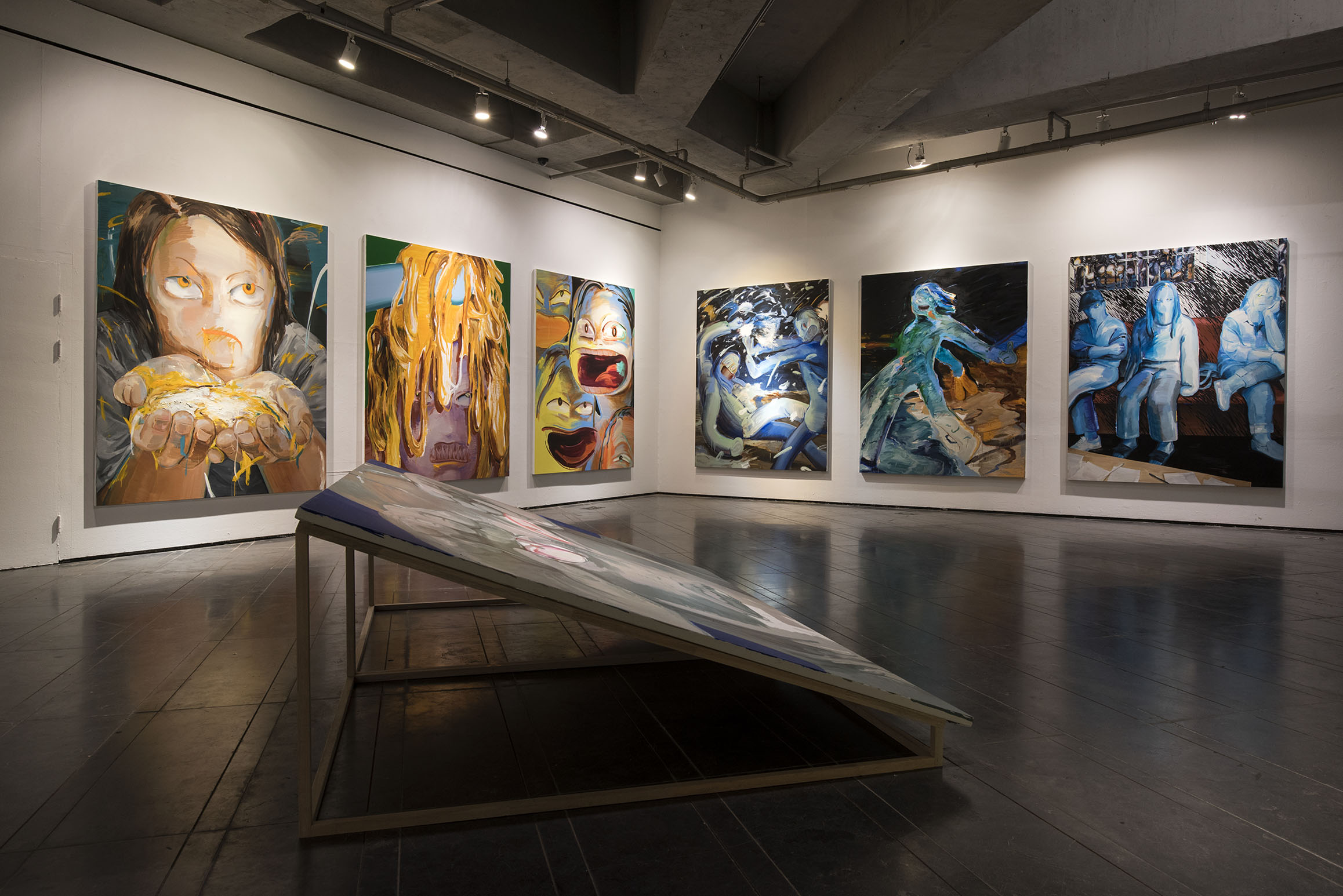
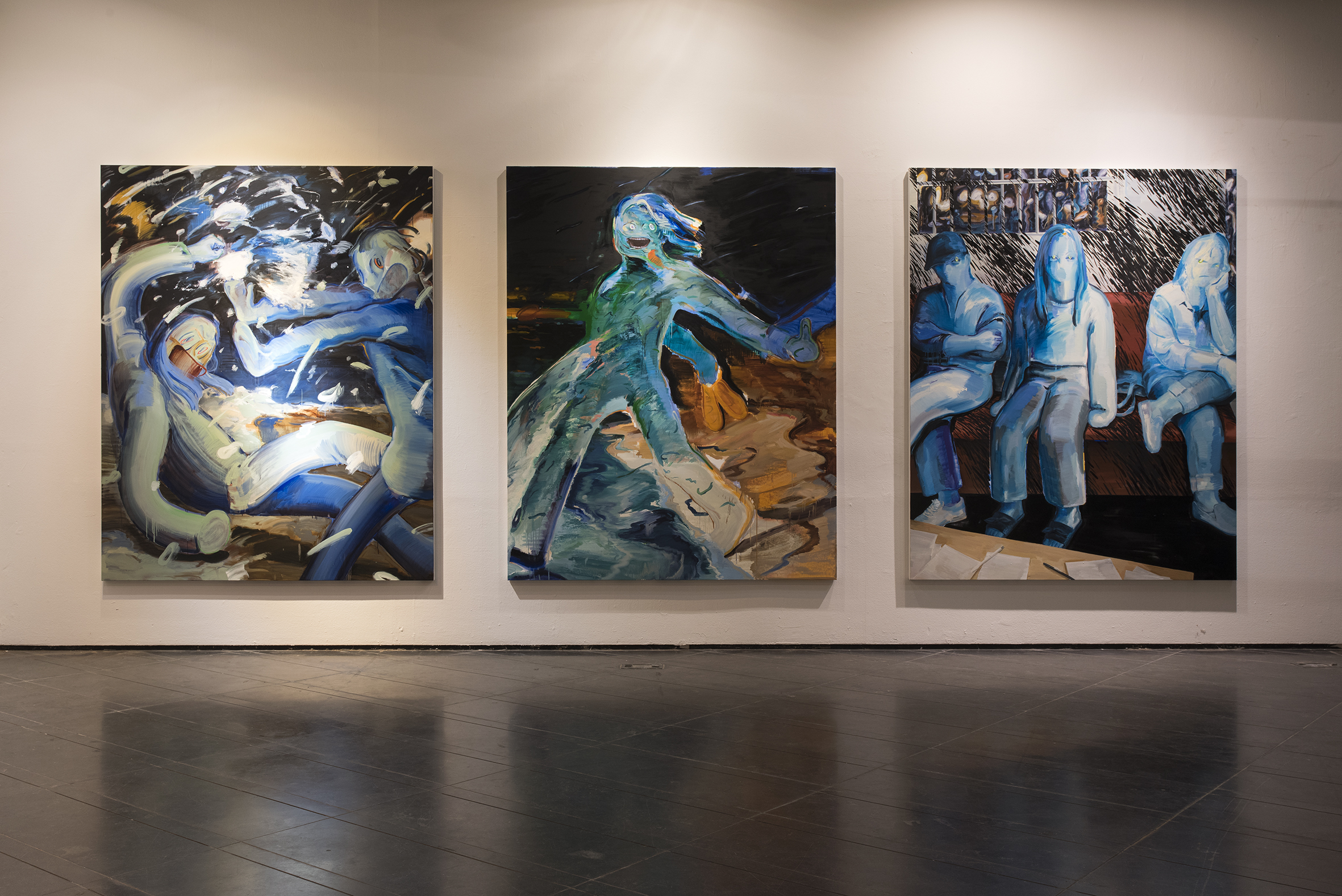

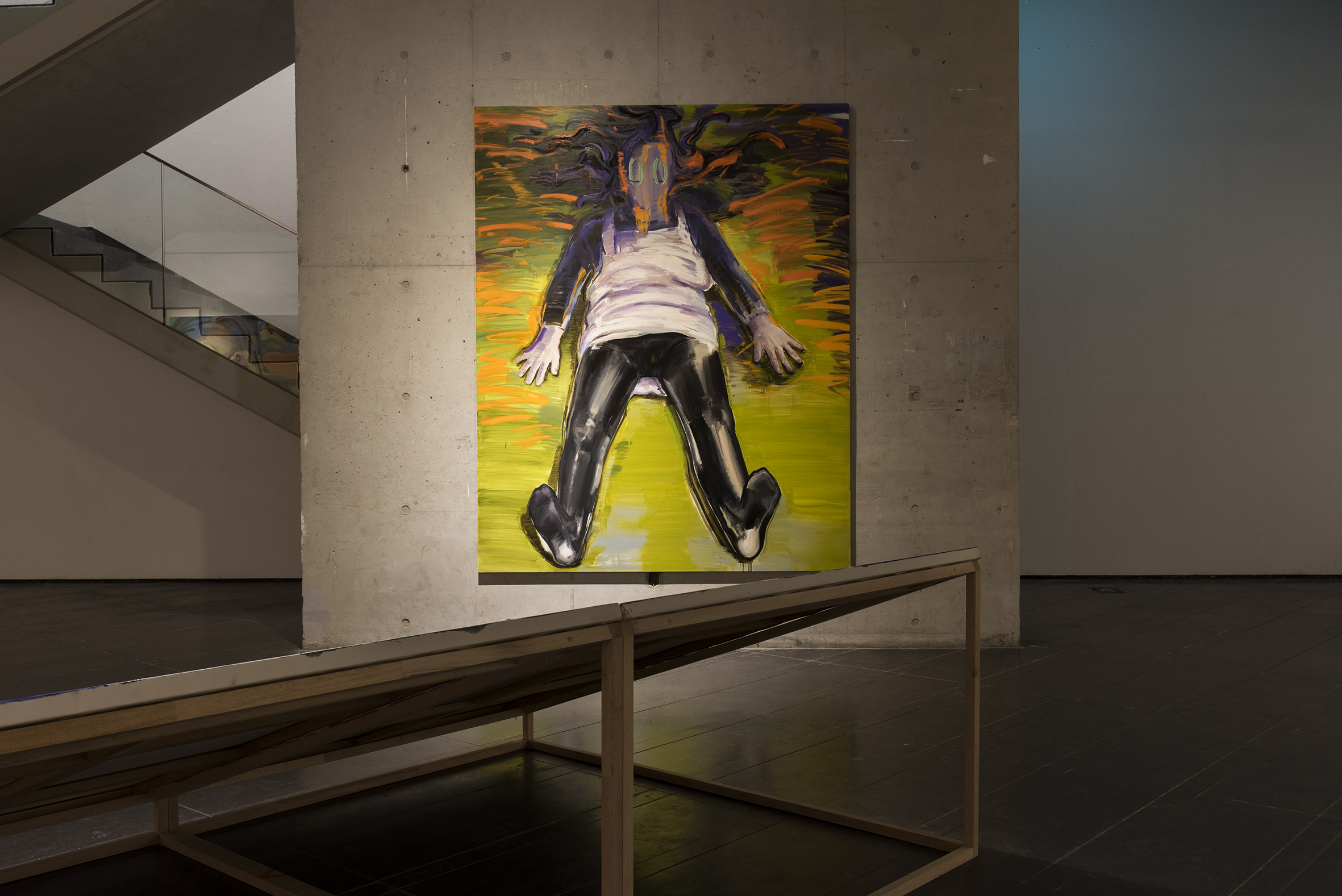
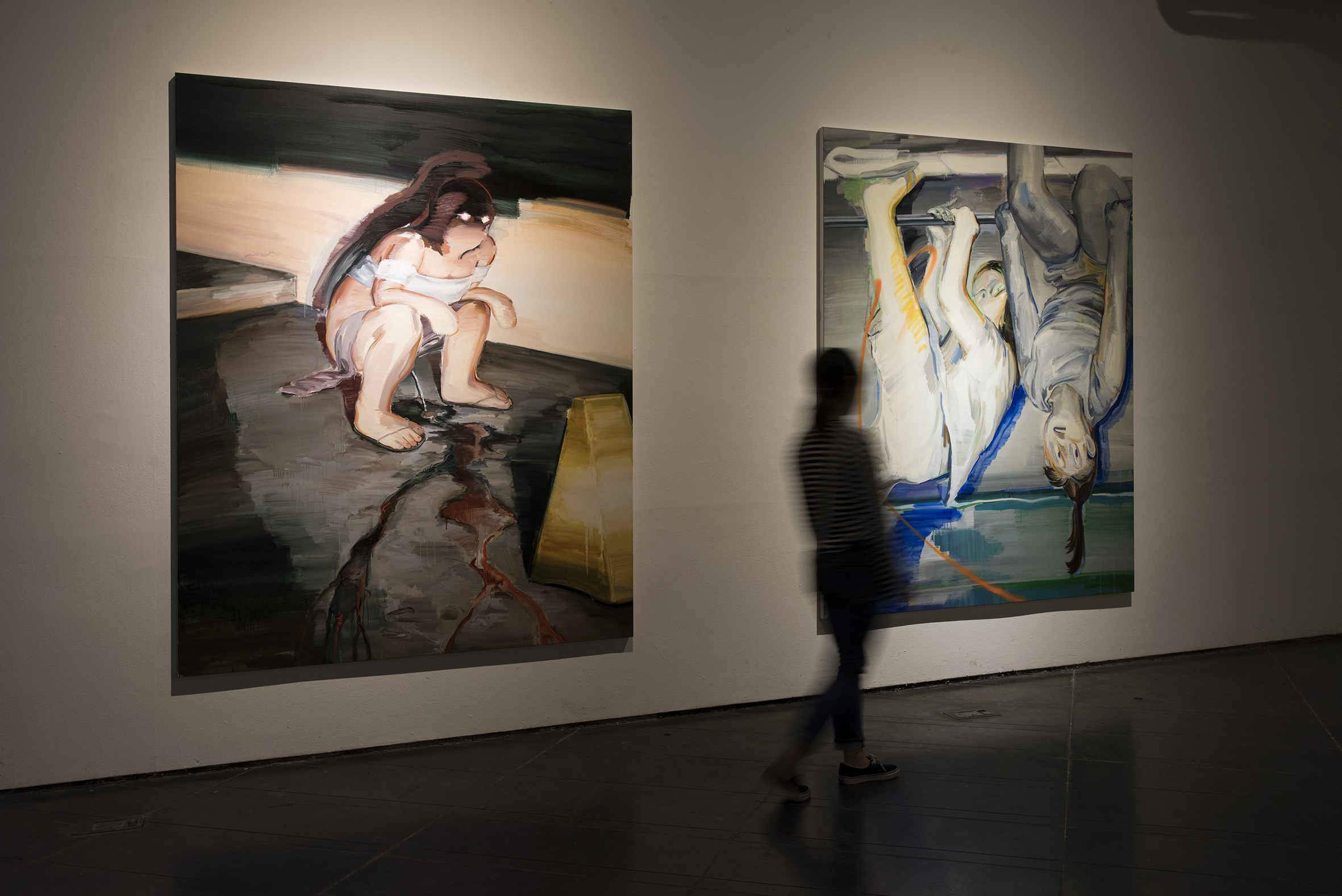
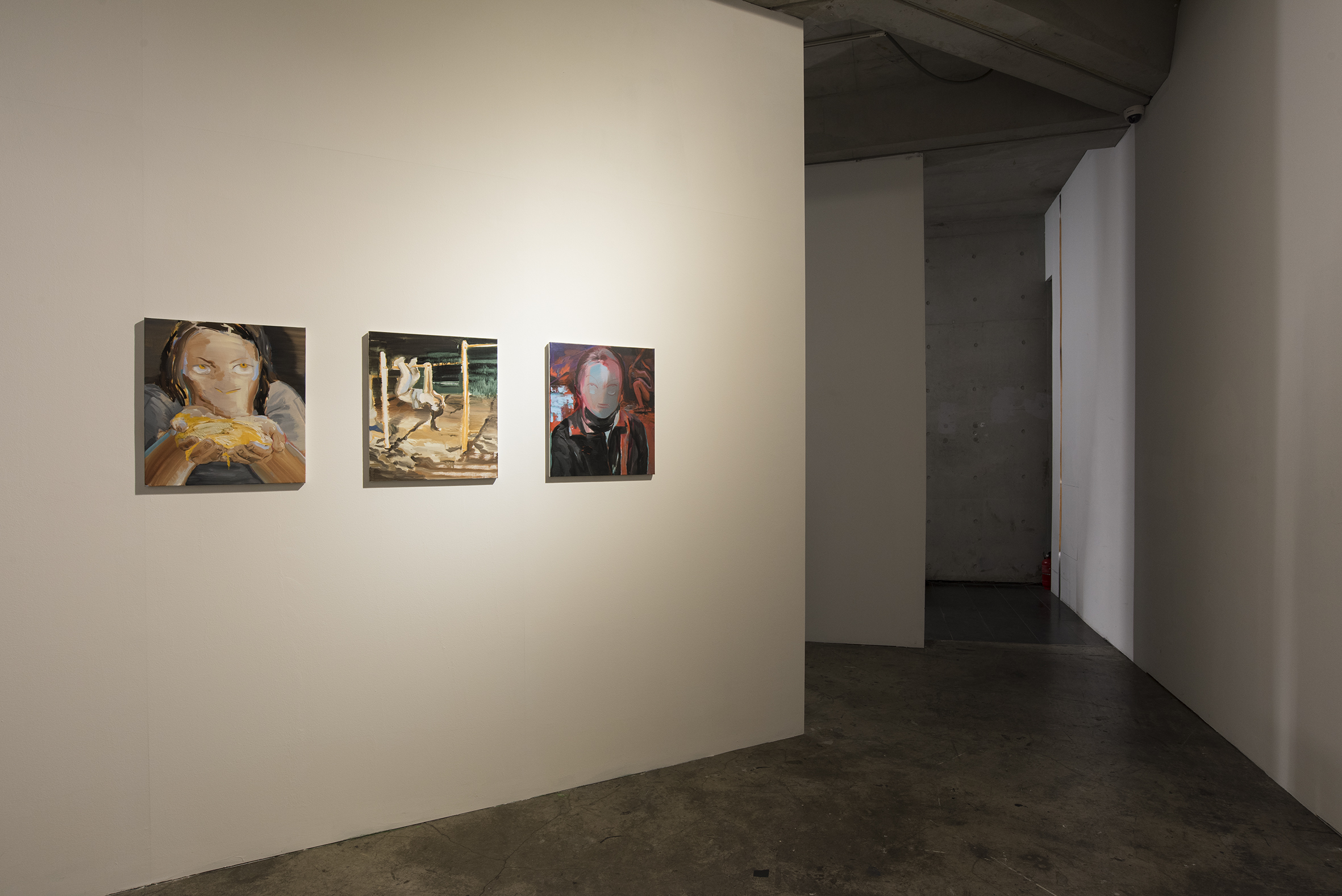
되돌리기 / 살피기
1.
이은새의 작업은 크게 세 단계로 구성된다. 첫째는 무언가 변형되는 상황이다. 둘째는 그 상황을 지켜보는 것이다. 셋째는 그러한 것들을 나열하는 것이다. 물론 그의 작업은 소재, 주제, 구도, 기법 등이 제법 다양하지만, 작품들은 서로 연결되면서 종합적인 의미망을 형성하는 경우가 많다. 그는 우리 주변이나 TV, 영화 등에서 소재를 발견한다. 어떤 것은 지극히 일상적이고 평범하지만, 어떤 것은 꽤나 도발적이고 파격적이다. 그가 소재를 선택하고 다룰 때, 그만의 기발하고 독창적인 감각이 돋보이며, 또한 소재에 대한 진지한 이해와 따뜻한 배려심이 묻어난다. 더불어 그의 표현적이고 과감한, 때론 즉흥적인, 붓질 뒤에는 몇 번이건 이미지를 수정했던 신중함과 꼼꼼함도 숨어 있다.
2.
우선적으로 이은새는 변형되는 순간을 포착한다. 하지만 그것은 단순히 물리적인 변형만을 지칭하지는 않는다. 그의 초기 작품 중 흥미로운 것이 ‘돌 던지는 사람’ 연작이다. 돌을 던지기 때문에 물 위에 파장이 일어나는데, 작가는 그 파장을 본 사람의 내면적 파장도 그림에 담고자 하였다. 그는 무언가 변형되면서 허점을 찌르는 것 같은 장면을 ‘틈’이라고 생각하였다. 그러한 틈이 생겼을 때, 즉 우리 주변에서 적극적이진 않더라도 일시적으로나마 영향을 끼치는 상황이 되었을 때를 그는 ‘전파상의 간섭’에 비유한 바 있다.
그리고 그런 것을 지켜보는 목격자가 화면에 종종 등장한다. 그 목격자는 사건을 접했던 작가일 수도 있고, 그림을 그리는 작가 자신일 수도 있고, 그림을 보는 관객일 수도 있다. 그런데 이은새는 자신의 위치가 애매하다는 점을 인정한다. 무언가를 지켜보면서 무언가를 해야 할 것 같지만, 아무 것도 제대로 하지 못하는. ‹앙다문 손›(2014)에서 그는 망설이면서 주먹을 쥐고 있다. 그는 일부러 물감을 더 두껍게 해서 손을 그렸다. 마치 물감에 힘을 주어 물감이 서로 맞대게 한 것처럼.
3.
이은새는 현실세계를 목격한다. 이어서 그가 본 것을 캔버스의 화면이라는 이미지의 세계로 가져온다. 초창기에는 맥락과 상관없이 필요한 장면을 추출하곤 했지만, 어느 순간부터 그런 태도에 불편함을 느꼈다고 한다. 그는 그것이 착취해서 소비하는 것 같았다고 말한다. 그는 그것을 ‘guilty’, ‘image’, ‘colony’라는 단어들로 지칭하였다. 작가라고 해서 현실세계의 것을 마음대로 가져다 쓸 수 있는 건 아니다. 그는 그가 목격한 것을 다시 생각한다. 목격하는 작가를 목격하는 작가.
2016년 11월 개인전에선 보는 것과 보이는 것 사이의 관계를 뒤집는 작업들이 전시되었다. 예를 들어 ‹강제 관람›(2016)은 눈 수술 광경이다. 의사가 환자의 눈을 강제로 크게 뜨게 하는데, 그 결과 환자의 눈이 커지고 강력해져서 오히려 환자가 상대방(의사, 작가, 관객)을 쳐다보는 모양새가 되었다. 또 ‹입 벌린 점›(2016)은 가슴 부근에 있는 점을 다룬 그림인데, 화면 속 인물은 노골적으로 가슴을 드러내면서 이 점을 보여주고 있다. 작가는 이빨을 가진 사람의 표정으로 이 점을 그리고 싶었다고 한다.
이처럼 이은새는 우리(관객)가 무언가를 보는 장면을 연출했는데, 동시에 그 대상도 우리를 쳐다보는 쌍방적인 상황을 만들었다. 그는 그림을 본다는 통념에 의문을 제기한다. 우리가 그림을 보는 것처럼 그림도 우리를 본다.
4.
‘밤의 괴물들’ 시리즈는 2017년 5월에 2점이 처음 발표되었다. 이번 개인전에서는 10여 점이 추가로 공개되었고 술 취한 여자들이 대상이다. 보통 술 취한 여자는 피해자, 약한 존재, 범죄의 표적이라는 이미지가 있다. 실제로 여러 사건을 떠올려보면 이 말이 틀린 것은 아니다. 그런데 작가는 술 취한 여자가 하나의 이미지로만 고착되는 것을 경계하며, 그들에 대해 색다른 접근을 시도한다.
그림의 내용은 작가와 그의 친구들이 경험했거나 작가가 상상한 것이며, 주로 술 먹은 후 벌어진 일 중에서 한 장면을 포착한 것이다. 따라서 화면의 장면은 다소 단편적일 수 있지만, 그와 관련된 배후의 이야기가 따로 있다. 그 이야기는 작품제목이나 인물의 동작, 표정 등의 정황증거를 통해 대략적으로 유추해 볼 수 있다.
한편 그림에 등장한 여자들은, 비록 취해서 정신이 없더라도, 연약하거나 기운이 없어 보이지는 않는다. 도리어 에너지가 넘쳐 보인다. 그들은 그들 앞에 있는 상대방 혹은 화면 앞에 있는 관객에게 당당하며, 심지어 공격적이기도 하다. ‹눈 비비는 사람›(2017)에서 인물은 (앞에 사람을 향해) 붉은 눈을 비비며 부라리고 있으며, ‹밤의 괴물들 - 토›(2018)에서는 (앞에 사람을 향해) 눈을 치켜뜨고 토한 것을 내밀고 있으며, ‹밤의 괴물들 - 철봉 운동›(2018)에서는 (앞에 사람을 향해) 킥을 날릴 것 같으며, ‹밤의 괴물들 - Beach Walk›(2017)에서는 (앞에 사람을 향해) 바다에 같이 들어가자고 말하는 것 같다. 이들의 당당한 태도는 두꺼운 물감, 거친 붓질, 강렬한 색채 등으로 표현되어 있다.
사실 이들은 어둠 속에 숨어있는 존재가 아니다. 이들 앞에는 항상 목격자가 있다. 그는 현장에 있는 사람이자 작가이자 관객이다. 그리고 이들은 그에게 어떤 행동을 한다. 화면에 등장하지 않는 그에게 어떤 행동을 한다. 이들 앞에 있는 그는 단순한 목격자라기보다는 이들과 관련된 사람이다. 그래서 이들의 행동은 지향성이 있는 행동이며, 그런 행동에 대한 목격 역시 지향성이 있는 행동이다. 이 지점이 이전 작업과의 차별성으로 보인다. 제3자로서 그저 바라보는 목격자가 아닌 그 상황에 참여하는 목격자이다. 이는 이전 작업에서 작가가 취했던 ‘앙다문’ 것과 ‘guilty’적인 것에 대한 나름의 반성으로 이해된다.
‘밤의 괴물들’ 연작은 전시장에 나열될 것이다. 밤의 괴물들은 관객을 향할 것이다. 다음은 관객 차례이다.
글: 류한승, 국립현대미술관 학예연구사
Revert / Observe
1.
Eunsae Lee’s oeuvre mainly consists of three stages. First is the process of transformation. Second is observing the transformation. Third is lining up those that transform in order. The themes, subjects, compositions and techniques of Lee’s oeuvre are actually quite diverse, but in many cases, they interconnect with one another to form a greater network of meaning. The artist finds the subject of her works from everyday life around us, or TV shows and movies. Some of them are simple and mundane, but some are rather unconventional and provocative. It is in her choice of the subject matter, however, that one can sense her brilliant and unique sensitivity, as well as her thorough understanding and thoughtfulness towards the subject. Moreover, behind her expressive, bold, and at times spontaneous brushstrokes, lie the traces of her countless revisions that reflect her painstaking and careful attention to detail.
2.
First and foremost, Eunsae Lee captures moments of transformation. However, this is not limited to physical transformation alone. One of the most interesting works from her early oeuvre is the Stone Throwing series. The painting depicts ripples made on the water by a stone, but more profoundly attempts to capture the inner ripple effect in the mind of the observer who stands before the water. Lee captures those moments of transformation which catches the viewers off guard with a sudden effect, and calls them “cracks.” When those “cracks” open up, in those moments that impact us even if for a split second in very subtle ways, the artist likens them to “electronic interference.”
A witness, who observes the transformation, frequently appears in the paintings. The observer may be the artist herself as a witness of the event, as a painter, or it could even be the viewer looking at the painting. On the other hand, Eunsae Lee acknowledges the fact that her position is ambiguous – witnessing something and feeling compelled to do something, but unable to do anything. In The Clenching Hands
(2014), she hesitantly closes her hands into a fist. The hands are intentionally painted in thick impasto, as if pressing on the paint to confront each another.
3.
Eunsae Lee witnesses the real world. She then transfers what she has witnessed into the world of image on canvas. In the early works, she used to pick out scenes without regard to its context but she explains that at some point, she began to feel uncomfortable with such attitude. She states that it felt as though she was consuming the images by exploiting them. She describes her feelings with words like “guilty,” “image” and “colony.” Being an artist does not give one the right to take and use anything of the real world at her will. She rethinks those that she has witnessed. She witnesses herself as a witness.
Lee’s solo exhibition in November 2016 presented a series of works that subverts the relationship between seeing and what is seen. For example, Forced View (2016) depicts a scene of an eye surgery. The surgeon forces the patient to keep his eyes wide open, but in the end, it appears as though it is the patient, with his eyes wide open, staring intensely at the surgeon. In A Mole with Sharp Teeth (2016), the painting shows a mole on a woman’s breasts, but the woman on canvas is showing the mole to explicitly show off her breasts. The artist explains that she wanted to paint the mole having facial expression and teeth.
In such a way, Eunsae Lee creates a two-way situation where the viewers looking at the canvas are also seen by the very object which they are looking at. By so doing, Lee questions the conventional idea of what it is to look at a painting. As we look at the painting, the painting looks at us.
4.
The Monsters of the Night series was first unveiled in May of 2017 with two new paintings. In the current exhibition, Lee introduces ten additional works from the series, portraying intoxicated women as the subject. In general, drunk women are often portrayed as victims, or vulnerable targets for crime. In light of recent events in reality,
perhaps this assumption is not completely wrong. On the other hand, Lee avoids falling into those stereotypical images of drunk women and examines the subject with a new and different approach.
The scenes in the paintings capture events that occur after drinking, inspired by real life experiences of the artist and her friends, or imagined by the artist. Though the scene that appear on canvas seem like a fragmentary snapshot, there are narratives that lie behind each scene. The narratives can be speculated through various clues such as the title of the work, or through actions and facial expressions of the figures on canvas.
At the same time, the women on canvas do not appear weak or worn down, though they may seem drunk or intoxicated. Rather, they look full of energy. They look confident to face the viewer or other figures in the image, and even seem aggressive. In Rubbing the Eyes (2017), the figure is shown rubbing her eye while glaring in the other eye (toward the viewer), and in Night Freaks – Vomit (2018), the figure glares (toward the viewer) intently while displaying her own vomit. In Night Freaks – Bar Exercise (2018), the figure appears as though she is about to throw a kick (toward the viewer), and in Night Freaks – Beach Walk (2017) the figure appears to invite the viewer to go into the water with her. The confident attitudes of the women are expressed on canvas with thick impasto, rough brushstrokes, and intense colors.
In fact, these women are not simply veiled existences hidden behind the darkness. There is always a witness who stands before them. They are the other people in the scene, the artist and the viewers. The women, in turn, take actions towards them – to those that lie outside the canvas. Therefore, all those who stand before the women are not just witnesses but they relate to one another. The actions of the women are directed towards them, and in turn, their gazes are specifically directed towards the women. This interaction seems to be what differentiates this series from Lee’s earlier works. As a third party, the witnesses are not just passive observers but they become active participants in the situation. Perhaps this change reflects the artist’s effort to make up for those which she described as “clenched” and “guilty” in her earlier works.
The Night Freaks series will be lined up on the gallery walls, and those monsters of the night will face their viewers. Now, it is the viewers’ turn to face them.
Written by Hanseung Ryu
Curator, National Museum of Modern and Contemporary Art, Korea
